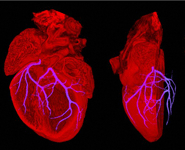The study, led by researchers from the University of Bristol’s School of Physiology and Pharmacology, show how two individual but very similar proteins cooperatively adjust the amount of calcium inside the heart cells, and how this dual regulation may degenerate in heart failure.
In the heart cells of healthy people, calcium is released from intracellular stores and causes the heart to beat strongly so that it can pump blood around the body. The intracellular stores of calcium are released through specialised gates called ‘ryanodine receptor (RyR) channels’ in a controlled manner at appropriate times and in suitable quantities. In patients with heart failure, release of intracellular calcium can become irregular and less tightly controlled resulting in an abnormal heart rhythm.
By removing individual RyR channels from heart cells and incorporating them into artificial membranes, the researchers were able to measure the tiny calcium currents that flow through a single channel molecule.
The team discovered that two individual proteins, called FKBP12 and FKBP12.6, bind tightly to the RyR channels and alter the amount of calcium that flows through them.
Their study shows that although FKBP12 and FKBP12.6 are almost identical, the proteins have very different functions. FKBP12 increases calcium fluxes through RyR channels while FKBP12.6 blocks the effects of FKBP12. It seems that this dual regulation by the two proteins may be damaged in heart failure.
Professor Rebecca Sitsapesan said: "Diseases of the heart and circulatory systems are the main cause of death in the UK and account for almost 191,000 deaths each year — one in three deaths1. These new findings are important because we can use this information to help develop new treatments for patients with heart disease to reduce the risks of sudden cardiac death.”
The British Heart Foundation-funded research, entitled ‘FKBP12 activates the cardiac ryanodine receptor Ca2+-release channel and is antagonised by FKBP12.6’, by E. Galfré, S. J. Pitt, E. Venturi, M. Sitsapesan, N.R. Zaccai, K. Tsaneva-Atanasova, S. O’Neill and R. Sitsapesan is published in PLoS ONE.
